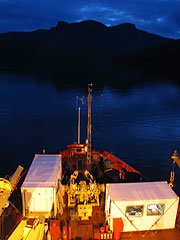

 | |||||||||||||
|
|
Journals 2007/2008Caitlin Munroe
July 31, 2007 Location: Northern Labrador, Anaktalak Fjord We are in Anaktalak Fjord and are surrounded by several small islands and mainland Labrador Steep cliffs covered in vertical striations reach down to greener areas covered with small evergreens and tundra. The tundra in turn gives way to short strips of rocky beach before meeting the water. One of the marine sedimentologists on board tells me that these cliffs are 1.5 billion years old! Greg and Klaus are out in the zodiac, collecting surface water samples and using the hyperspectral profiler. There are two sensors on the profiler (one faces up, one down) to record the downwelling and upwelling light as it slips down into the water. Greg explained that water scatters and absorbs light of differing wavelengths to varying degrees, so that as you sink down into the ocean red is lost first, then orange, yellow and green. At some point blue light would be all that is visible. He and Klaus are looking for digressions from that general pattern. Dissolved organic matter absorbs blue preferentially and a lot of DOM would mean blue is lost most quickly, then green. Enough DOM would invert the pattern, absorbing all other light until a brownish red was left. On the bow of the Amundsen, Andrea is running the Hypersas which measures the spectral characteristics of light reflected off the surface to get a better idea of how substances in the water determine the color we see from above. This would allow for measurement of concentrations of organic matter, algae, or suspended silt and clay particles from satellite images. Others use the changing spectral characteristics of light in the water column because these characteristics determine how successfully algae will covert CO2 into living matter. The spectral characteristics of light in the water column also determine how colorful fish will be, which serve fish as species-distinguishing markers.
|
||||||||||||

